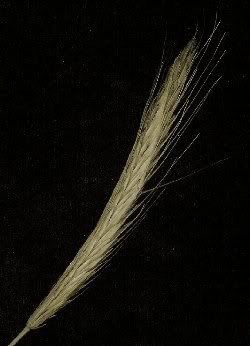
ז' שבט ה'תשס"ז
Note that today's Hebrew date rests like a double shabbat, a shabbat shabbaton, and like the double edges of a witch's athame, between two letters zayin (ז ... ז).
The second product of the Land that we traditionally eat during Tu B'Shevat is barley. The word in Devarim 8:8 is ושׂערה meaning "and barley", where the first [1] letter is a vav (ו) of connection called a vav hachibur. This is the vav which reconnects the letter yod to the letter chet in the word wheat (חיטה) as discussed in my previous entry, Wheat - From Galut To Geulah (from exile to redemption).
Evidence for this reconnection is found in the root שׂער of the word for barley, which implies a strong movement from within [2]. The first letter of the root is sin ("s" sound) as opposed to shin ("sh" sound), with a nikud (dot) over the left pillar as opposed to the right pillar. Consequently, we can see that the movement manifests through action of the feminine left emanation.
What is this movement? It is the movement described in Sefer Yetzirah 1:6 and 6:1 as a stormwind, the se'arah. Ruach se'arah [3] is a klipah (as I've distinguished previously here, Sufah and Se'arah), in contradistinction to ruach hakodesh or divine inspiration. Like its ezer knegdo, the shoresh "against it" (שרע), it implies stretching and extending in response to a strong inner movement. In other words, it is deliberate, measured, active work. This klipah gives the soul something to push and pull against enabling growth. As a yetziratic "agitating wind" meant to loosen distorted complexes in the soul for removal and/or reconstruction, ruach se'arah is neither as powerful nor as potentially destructive as Ruach HaShem. Ruach se'arah results when the human moves toward the divine. Ruach HaShem results when the divine bestows upon the human. Consequently, the powerful presence of the "chaotic dynamic" described here is evidence that the reconnection has been established.
In my own life, this dynamic is discussed most notably here (Soul Of A Bat Kohen) and here (Modah Ani).
Footnotes:
[1] Hebrew is read right to left, as opposed to from left to right as with English.
[2] Etymological Dictionary Of Biblical Hebrew, R' Matityahu Clark
[3] Inner Space, R' Aryeh Kaplan
Technorati tags: Torah Talmud Torah Judaism Kabbalah jewish mysticism mysticism jewish meditation meditation shamanism jewish shamanism kabbalah iyunit kabbalah maasit jewitchery jewitch jewish woman sacred feminine divine feminine shechinah lilith spiritual development spirituality kosher spirituality tu b'shevat
Thursday, January 25, 2007
Barley - Evidence Of Reconnection
Posted by
Lori
at
5:30 PM
![]()
Labels: athame, botanicals, hebrew rootwork, holy days, kabbalah, kehunah, sefer yetzirah, shabbat, shabbat consciousness, tools, tu b'shevat, witch
Subscribe to:
Post Comments (Atom)
Dare to be true to yourself.








No comments:
Post a Comment